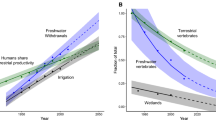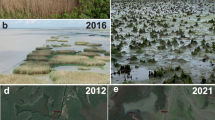Abstract
The Sultansazligi Wetland, an internationally important aquatic site in Turkey, has suffered from a severe contraction since the early 1990s. To determine the factors affecting contraction, temporal variations of climatic and hydrogeologic variables have been investigated. Both the long-term climate change and the increasing surface and groundwater use are found to be responsible. Hydrologic analyses reveal an apparent correlation between increasing use of water resources and contraction in the wetland. Particularly, increasing use of groundwater and complete capture of springs and effluent streams once feeding the wetland are found to be the prime factors. Furthermore, a strong coherence is found between the temporal trend of the North Atlantic Oscillation and local precipitation, which is the main source of the basin’s water excess and supplies the wetland. Future existence of the wetland depends on the application of thrifty water-use polices in irrigation.
Résumé
Le Sultansazligi Wetland, un site humide Turc d’importance internationale, a subi d’importantes réductions de surface depuis le début des années 1990. Pour déterminer les facteurs de la réduction de la zone humide, on a étudié les fluctuations du climat et des variables hydrogéologiques. On a trouvé qu’à la fois le changement climatique à long terme et l’accroissement de l’utilisation du sol et de l’eau souterraine se révèlent comme étant responsables. Les analyses hydrologiques révèlent une apparente corrélation entre l’utilisation croissante des ressources en eau et la réduction de surface de la zone humide. En particulier, l’utilisation croissante de l’eau souterraine et le captage intégral des sources et des cours d’eau ayant autrefois alimenté la zone humide sont reconnus comme en étant les facteurs principaux. De plus, on trouve une forte corrélation entre la tendance de l’Oscillation Nord Atlantique et les précipitations locales, principales source d’eau excédentaire du bassin alimentant la zone humide. L’existence future de la zone humide dépend de l’application à l’irrigation d’une police de l’eau économe.
Resumen
El humedal Sultansazligi, un sitio acuático internacionalmente importante en Turquía, ha sufrido una severa contracción desde los primeros años de la década del 90. Para determinar los factores que afectan la contracción se han investigado las variaciones climáticas temporales e hidrogeológicas. Se encontró que tanto el cambio climático a largo plazo como el uso creciente de agua subterránea y superficial son los responsables. Los análisis hidrogeológicos revelan una correlación aparente entre el incremento en el uso de los recursos de agua y la contracción en el humedal. En particular, se encontró que los principales factores son el incremento del uso de agua subterránea y la captura completa de los manantiales y corrientes efluentes que alguna vez alimentaron subterráneamente al humedal Más aún, se encontró una fuerte coherencia entre la tendencia temporal de la oscilación del Atlántico Norte y las precipitaciones locales, que es el origen principal de los excesos de agua de la cuenca y abastecimiento del humedal. La existencia futura del humedal depende de la aplicación de políticas cuidadosas en el uso del agua para irrigación.
摘要
Sultansazligi 湿地是土耳其境内具有国际性意义的水域,但从 20 世纪 90 年代开始退化非常严重。为了分析影响退化的原因,我们调查了研究区内气候和水文地质变量随时间变化的特征。结果表明,长期的气候变化和地表地下水利用的增加都是相应的原因。水文分析显示水资源利用的增加与湿地的退化密切相关。尤其是地下水利用量的增加和原本补给湿地的泉水与河流的全面利用是首要原因。本地降水既是该流域内过量水的来源,也是湿地的补给源,进一步研究发现,本地降水与北大西洋涛动的变化趋势一致。湿地的未来取决于节约灌溉水政的实施。
Resumo
A zona húmida de Sultansazligi, um sítio aquático importante a nível internacional na Turquia, sofreu uma forte contração desde o início da década de 1990. Tendo em vista determinar os factores que afetam a contração, investigaram-se as variações temporais de variáveis climáticas e hidrogeológicas. Verificou-se que, tanto a alteração climática de longo termo, como a utilização crescente de águas superficiais e de águas subterrâneas foram responsáveis por esse fato. A análise hidrológica revela uma aparente correlação entre o uso crescente dos recursos hídricos e a contração da zona húmida. Em particular, verifica-se que os factores principais responsáveis por este processo são o uso crescente de águas subterrâneas e a captação completa das nascentes e dos cursos de água efluentes que alimentavam a zona húmida. Além disso, encontra-se uma forte coerência entre a tendência temporal da Oscilação do Atlântico Norte e a precipitação local, que é a principal origem de excedente hídrico da bacia e abastece a zona húmida. A existência futura da zona húmida depende da aplicação de políticas parcimoniosas de utilização da água na rega.
Öz
Türkiye’deki uluslararası öneme sahip sucul ekosistemlerden Sultansazlığı sulak alanı 1990’lardan günümüze önemli düzeyde küçülmüştür. Küçülmeye neden olan etkenlerin belirlenmesi için iklimsel ve hidrojeolojik değişkenlerin zamansal değişimi incelenmiştir. Uzun sureli iklim değişimi ile yüzey ve yeraltısularının artan kullanımının küçülme üzerinde etkili olduğu belirlenmiştir. Hidrolojik analizler su kaynaklarının artan kullanımı ile sulak alandaki küçülme arasında belirgin bir korelasyon olduğunu göstermiştir. Özellikle, bir zamanlar sulak alanı besleyen kaynakların ve akarsuların tamamen sulamaya tahsis edilmesinin ve artan yeraltısuyu kullanımının küçülme üzerinde etkili temel faktörler oldukları belirlenmiştir. Bunun ötesinde, sulak alanı besleyen ve havzadaki su fazlasının başlıca kaynağı olan yağış ile Kuzey Atlantik Salınımının zamansal eğilimleri arasında güçlü bir ilişki bulunmuştur. Sulak alanın gelecekteki devamlılığı tutumlu sulama politikalarının uygulanmasına bağlıdır.










Similar content being viewed by others
References
Akcakaya HR, Baris YS, Bilgin CC (1983) Sultan Marshes Conservation Project final report (in Turkish). Middle East Technical University, Ankara, Turkey, 30 pp
CRU (2011) Climate Research Unit, UK. http://www.cru.uea.ac.uk/cru/data/nao/nao.dat. Cited 24 February 2011
Dadaser-Celik F (2008) Impact of large-scale irrigation on a closed basin wetland: water flow alterations and participatory irrigation management effects on the Sultan Marshes ecosystem in Turkey. PhD Thesis, University of Minnesota Twin Cities, USA
Dadaser-Celik F, Stefan HG, Brezonik PL (2006) Dynamic hydrologic model of the Ortülüakar Marsh in Turkey. Wetlands 26:1089–1102
Dadaser-Celik F, Brezonik PL, Stefan HG (2007) Hydrologic sustainability of the Sultan Marshes in Turkey. Water Int 32(5):856–876
Dadaser-Celik F, Brezonik PL, Stefan HG (2008a) Agricultural and environmental changes after irrigation management transfer in the Develi Basin Turkey. Irrig Drain Syst 22:47–66
Dadaser-Celik F, Bauer ME, Brezonik PL, Stefan HG (2008b) Changes in the Sultan Marshes ecosystem (Turkey) in satellite images 1980-2003. Wetlands 28:852–865
Dadaser-Celik F, Coggins JS, Brezonik PL, Stefan HG (2009) The projected costs and benefits of water diversion from and to the Sultan Marshes (Turkey). Ecol Econ 68:1496–1506
Dönmez M, Akcay AE, Türkecan A (2005) Geological Maps of Turkey (in Turkish), Kayseri K34 Plate, Gen. Directorate of MTA, Ankara, Turkey, pp 2–19
DSI (1993) Main report of basin water balance considering the environmental impacts of Develi Project and recommended measures (in Turkish). Gen. Directorate of DSI, Ankara, Turkey, pp 63–64
DSI (1995) Revised hydrogeologic study of Develi-Yesilhisar Basin (in Turkish). Gen. Directorate of DSI, Ankara, Turkey, 64 pp
DSI (1997) Report on the effect of Develi Project on the Sultansazligi and Yay Lake and the measures to be taken (in Turkish). Directorate DSI XII Region, Kayseri, Turkey, pp 16–17
ENCON (1999) Final report of the Project on Biological and Ecological Investigation of the Internationally-important Wetlands, Ministry of Environment, Ankara, Turkey
Erol O (1999) A geomorphological study of the Sultansazligi Lake, central Anatolia. Quat Sci Rev 18:647–657
Gürer I (2004) Final report on the investigation of the water use and management of the Sultansazligi Nature Protection Area (in Turkish). Ministry of Environment and Forests, Ankara, Turkey, pp 4–87
Gürer I, Unal A, Yildiz FE, Unsal N (2005a) Final report of WMO-ESA Project for the Utilization of ENVISAT Data: determination of surface flow and subsurface flow intrusion of Sultansazligi by using GIS and isotopes. European Space Agency, Frascati Italy, pp 38–59
Gürer I, Yildiz FE, Unsal N (2005b) Final report on the investigation of the interaction between surface and groundwater in the Sultansazligi-Kayseri (in Turkish). Gazi University, Ankara, Turkey
Hurrell JW (1995) Decadal trends in the North Atlantic Oscillation: regional temperatures and precipitation. Science 269:676–679
Karadeniz N (2000) Sultansazligi Ramsar site in Turkey. Hume dales Mediterráneos 1:107–114
Kiziroglu I, Turan L, Erdogan A (1992) Eco-ornitology of the Sultan Marshes and its latest state. J Hacet Univ Educ Fac 7:217–227
Kocyigit A, Erol O (2001) A tectonic escape structure: Erciyes pull-apart basin, Kayseri, central Anatolia, Turkey. Geodinam Acta 14:133–145
Kucuk M, Kahya E, Cengiz TM, Karaca M (2009) North Atlantic Oscillation influences on Turkish lake levels. Hydrol Process 23:893–906
Mitsch WJ, Gosselink JG (1993) Wetlands. Reinhold, New York
MTA (2005) Geological maps of Turkey L34 Plate. MTA, Ankara
NCAR (2011) National Center for Atmospheric Research, USA. www.cgd.ucar.edu/cas/jhurrell/indices.html. Accessed October 2011
Ozaslan M, Seftalici H (2002) Kayseri development report, State Planning Organization General Directorate of Regional Development and Structural Adjustment, Ankara, Turkey
Ozesmi U, Gürer I (2003) Sultansazligi: biodiversity and natural resources management pilot project in Turkey (GEF-II) In: Assessment and provision of environmental flows in Mediterranean watercourses: basic concepts methodologies and emerging practice. Mediterranean Case Study IUCN-The World Conservation Union. IUCN, Bonn, Germany. Available online at: http://cmsdata.iucn.org/downloads/turkey.pdf . Cited 24 October 2011
Ozesmi U, Somuncu M, Tuncel H (1993) Sultan marshes ecosystem (in Turkish). J Ank Univ Turk Geogr Res Appl Cent 2:275–288
Pasaoglu S (1994) DSI Develi Basin Ecology Conservation Project, Proc. of the Environmental Problems of Kayseri Sultan Marshes (in Turkish), Mount Erciyes Symposium, Kayseri Governer’s Office, Kayseri, Turkey, 1994, pp 86–122
RAMSAR (2011) Ramsar Convention on Wetlands. RAMSAR, Gland, Switzerland. www.ramsar.org. Cited 24 February 2011
Theis CV (1940) The source of water derived from wells. Civ Eng 10(5):277–280
Turkes M, Erlat E (2005) Climatological responses of winter precipitation in Turkey to variability of the North Atlantic Oscillation during the period 1930–2001. Theor Appl Climatol 81:45–69
Wild M, Gilgen H, Roesch A, Ohmura A, Long CN, Dutton EG, Forgan B, Kallis A, Russak V, Tsvetkov A (2005) From dimming to brightening: decadal changes in solar radiation at earth’s surface. Science 308:847–850
Yildiz FE (2009) Investigation of the groundwater and surface water relationship in the Sultansazligi Wetland (Kayseri) (in Turkish). PhD Thesis, Institute of Science Gazi University, Ankara, Turkey, 216 pp
Yildiz FE, Gürer I (2008) Determination Of groundwater: surface water relation by using environmental isotopes at Sultansazligi Wetland, Turkey. Proc. of BALWOIS 2008, Ohrid, Republic of Macedonia, 27–31 May 2008
Yildiz FE, Gürer I (2009) An integrated water resources management of Sultansazligi Closed Basin in Kayseri Turkey (in Turkish). GU J Sci 22(3):203–213
Acknowledgements
The authors thank Dr. N. Ozyurt (Hacettepe University, Ankara, Turkey) and Dr. Dadaser-Celik (Erciyes University, Kayseri, Turkey) for fruitful discussions and critical review of the draft manuscript. We also thank to Dr. Philips and Dr. Hurrell (University of California) for enlightening information provided on NAOI. We thank Dr. Türkes (COMU, Turkey) for explanations regarding the effect of NAOI on the climate in Turkey. The support of Mrs. Demirsu (Hydrogeological Engineer, DSI-Kayseri, Turkey) in accessing unpublished hydrologic data is gratefully acknowledged. We thank Mr. B. Topuz for his neat map drawings. Comments by the anonymous reviewers and the editors helped a lot to improve the manuscript.
Author information
Authors and Affiliations
Corresponding author
Rights and permissions
About this article
Cite this article
Bayari, C.S., Yildiz, F.E. Effects of the North Atlantic Oscillation and groundwater use on the contraction of Sultansazligi Wetland, Turkey. Hydrogeol J 20, 369–383 (2012). https://doi.org/10.1007/s10040-011-0809-z
Received:
Accepted:
Published:
Issue Date:
DOI: https://doi.org/10.1007/s10040-011-0809-z




